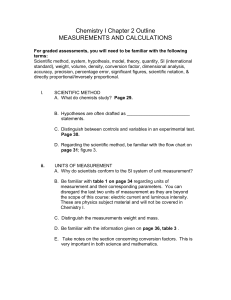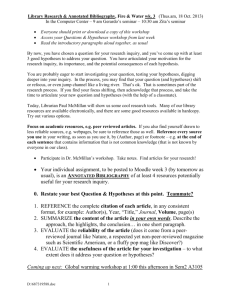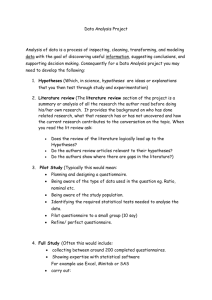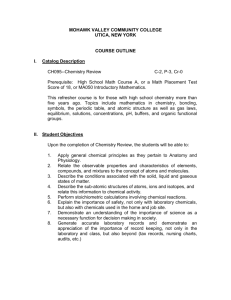Lab 1: Accuracy and Precision
advertisement
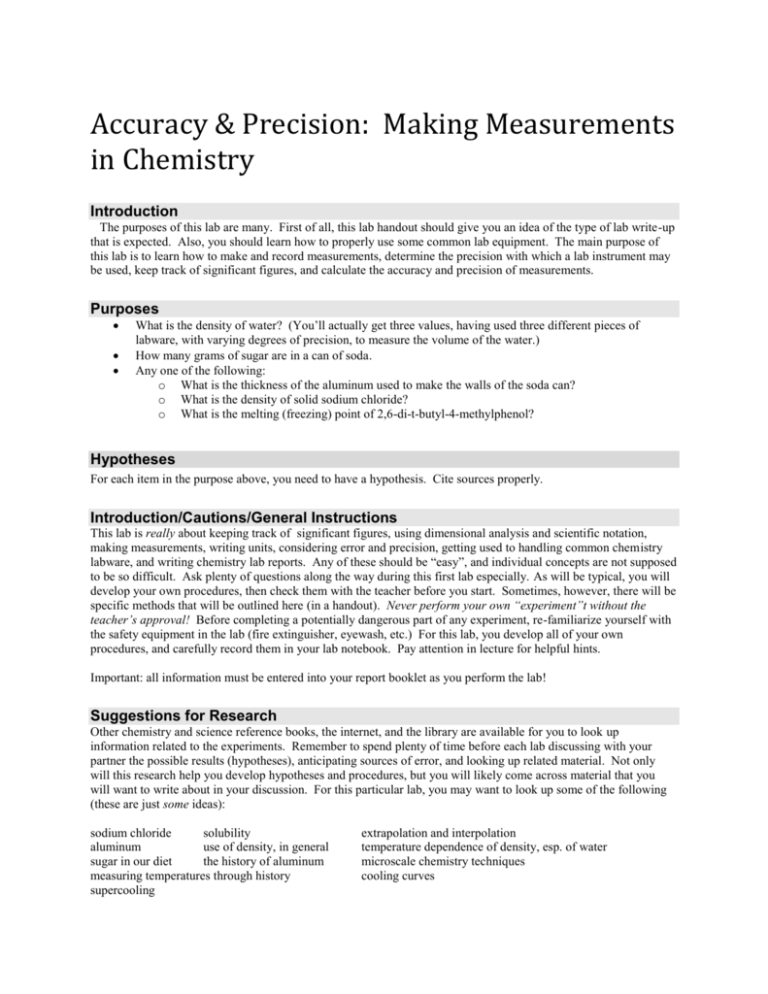
Accuracy & Precision: Making Measurements in Chemistry Introduction The purposes of this lab are many. First of all, this lab handout should give you an idea of the type of lab write-up that is expected. Also, you should learn how to properly use some common lab equipment. The main purpose of this lab is to learn how to make and record measurements, determine the precision with which a lab instrument may be used, keep track of significant figures, and calculate the accuracy and precision of measurements. Purposes What is the density of water? (You’ll actually get three values, having used three different pieces of labware, with varying degrees of precision, to measure the volume of the water.) How many grams of sugar are in a can of soda. Any one of the following: o What is the thickness of the aluminum used to make the walls of the soda can? o What is the density of solid sodium chloride? o What is the melting (freezing) point of 2,6-di-t-butyl-4-methylphenol? Hypotheses For each item in the purpose above, you need to have a hypothesis. Cite sources properly. Introduction/Cautions/General Instructions This lab is really about keeping track of significant figures, using dimensional analysis and scientific notation, making measurements, writing units, considering error and precision, getting used to handling common chemistry labware, and writing chemistry lab reports. Any of these should be “easy”, and individual concepts are not supposed to be so difficult. Ask plenty of questions along the way during this first lab especially. As will be typical, you will develop your own procedures, then check them with the teacher before you start. Sometimes, however, there will be specific methods that will be outlined here (in a handout). Never perform your own “experiment”t without the teacher’s approval! Before completing a potentially dangerous part of any experiment, re-familiarize yourself with the safety equipment in the lab (fire extinguisher, eyewash, etc.) For this lab, you develop all of your own procedures, and carefully record them in your lab notebook. Pay attention in lecture for helpful hints. Important: all information must be entered into your report booklet as you perform the lab! Suggestions for Research Other chemistry and science reference books, the internet, and the library are available for you to look up information related to the experiments. Remember to spend plenty of time before each lab discussing with your partner the possible results (hypotheses), anticipating sources of error, and looking up related material. Not only will this research help you develop hypotheses and procedures, but you will likely come across material that you will want to write about in your discussion. For this particular lab, you may want to look up some of the following (these are just some ideas): sodium chloride solubility aluminum use of density, in general sugar in our diet the history of aluminum measuring temperatures through history supercooling extrapolation and interpolation temperature dependence of density, esp. of water microscale chemistry techniques cooling curves Lab 1: Accuracy and Precision Needs Improvement: Title Page Grammar Usage Spelling Mechanics Organization Overall Neatness Purpose Hypothesis Materials Procedure Data & Observations Sample Calculations Results Discussion Title, name, partner’s name, and date Too many spelling errors Too many grammatical errors Not organized properly Messy handwriting Mistakes not neatly crossed out Paper hanging out of book Use pen (not pencil) Don’t use white-out Purposes not accurate or complete Hypotheses lacking insight, or not clear Sources of information for hypotheses missing Materials incomplete or lacking Not enough details Data and results mixed in unnecessarily Too many details (too fussy) Complete sentences should be used throughout Other information (data, results) included Data incomplete Format not well-planned Line up decimal points Use a ruler Units not shown Results, calculations or other stuff mixed in Check your significant figures Not shown Incomplete Only show one example of each type of new calculation encountered in chemistry (10) Incomplete Density of water (beaker/grad cyl/pipet) Sugar Content of Sprite Your choice You should have obtained a bit more accuracy You should have obtained much more accuracy Messy/use a ruler Need percent error No introduction Did not reflect on error in the lab More insight needed when considering possible sources of error More insight needed when attempting to place this lab into context (a) in the class or (b) in the “real world” Lack of research. No sources or incorrect format. Debriefing: Did not reflect (well) on things like “group dynamics”, or personal insight gained Late (-5 pts/day) Safety violation (varies) (10) Other Point Total (10) (10) (15) (10) (25) Extra Special! Title Page: (1st page) your name, your partner’s name, the date turned in, and the experiment’s title. Purpose, Hypotheses, Materials: The purpose consists of one or two sentences clearly stating the objectives of the lab. The hypothesis section is simply a list of the probable and expected result(s) for the lab. You must include sources of information that you used to determine your hypotheses. The materials section is a list of all substances (elements, compounds, solutions with concentrations) followed by equipment (beakers, etc.) needed to complete the lab. Procedure: (one or two pages) A listing of the steps performed in carrying out the lab. You should write in complete sentences, but be brief and to-the-point. You may write a step-by-step procedure, or in the form of several paragraphs. Do not include any purposes, data, calculations, results, or extra commentary here. Someone reading this should be able to obtain your results by following your procedure, without having to “read between the lines”. Included labeled diagrams, and refer to them in the text that you create: "Build the set-up as shown in figure 1..." Data and Observations: (usually one page) Prepare a table of data that neatly shows every essential measurement you made for each of the steps in the procedure. Make sure each measurement you record shows the correct number of significant figures. “Neat” means that all decimals line up and units are shown. Use a ruler. Any graphs should be titled and fully labeled. Make certain also that your data is absolutely complete, and you don’t leave out any measurement that you make. Written descriptive observations should use the “correct” terminology found in chemistry books. All data and observations must be recorded in the lab notebook. Sample Calculations: (perhaps one page, usually less) Show one example for each new type of calculation you encountered in the lab. Start with the algebraic expression, and then replace variables with some of your actual data that you collected, finally showing the result that you obtained. Results: (very short, usually) Make a table of results which shows only the final conclusions and percentage errors. Make sure each of the items mentioned in the purpose section is addressed. The table is ONLY final results and percent error. Discussion: (usually the longest section, if you’ve done a decent job) This is perhaps the most important, and longest, section in the lab write-up. Start with a short intro. This should be a paragraph of 2 or 3 sentences. Evaluate error: Be specific and give examples. For example, if the density of water result was always too high, state this and relate any errors that could have caused this error. Avoid generalities. After describing errors, give ways to avoid them for the next chemist doing the lab. In your opinion, was the amount of error acceptable? If not, think of specific (procedural) reasons why you ended up with unacceptable amounts of error, and tell how you could do things differently "next time". Relate the lab and its ideas to new ideas we have learned in class. This should include some research. Debriefing: Comment on the lab (and unit) as a “learning opportunity”, some feedback for the instructor.




